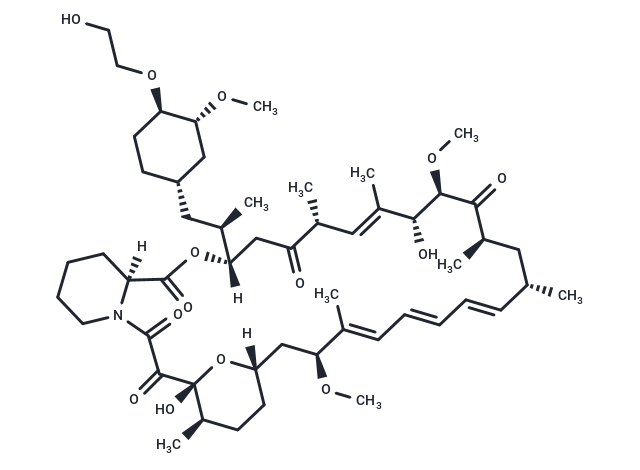购物车
- 全部删除
 您的购物车当前为空
您的购物车当前为空

Everolimus (SDZ-RAD) 是 Rapamycin 的衍生物,是一种 mTOR1 抑制剂,具有选择性和口服活性。Everolimus 具有免疫抑制和抗肿瘤活性,可以抑制肿瘤细胞增殖、诱导细胞凋亡和自噬。

Everolimus (SDZ-RAD) 是 Rapamycin 的衍生物,是一种 mTOR1 抑制剂,具有选择性和口服活性。Everolimus 具有免疫抑制和抗肿瘤活性,可以抑制肿瘤细胞增殖、诱导细胞凋亡和自噬。
| 规格 | 价格 | 库存 | 数量 |
|---|---|---|---|
| 1 mg | ¥ 196 | 现货 | |
| 5 mg | ¥ 435 | 现货 | |
| 10 mg | ¥ 655 | 现货 | |
| 25 mg | ¥ 1,250 | 现货 | |
| 50 mg | ¥ 2,190 | 现货 | |
| 100 mg | ¥ 3,520 | 现货 | |
| 200 mg | ¥ 4,280 | 现货 | |
| 1 g | ¥ 6,590 | 现货 | |
| 1 mL x 10 mM (in DMSO) | ¥ 589 | 现货 |
| 产品描述 | Everolimus (SDZ-RAD) is a derivative of Rapamycin, an mTOR1 inhibitor with selective and oral activity. Everolimus exhibits immunosuppressive and antitumor activity, inhibiting tumor cell proliferation, inducing apoptosis and autophagy. |
| 靶点活性 | mTOR FKBP12:1.6-2.4 nM (cell free) |
| 体外活性 | 方法:原发性乳腺癌细胞和 BT474 细胞用 Everolimus (0.001-10 µM) 处理 24 h,使用 MTT assay 检测细胞活力。 结果:Everolimus 对原发性乳腺癌细胞和 BT474 细胞具有剂量依赖性抑制作用,IC 50 分别为 156 nM 和 71 nM。[1] 方法:乳腺癌细胞 MCF-7 和 BT474 用 Everolimus (5 mg/mL) 处理 48 h,使用 Flow cytometry 检测细胞凋亡情况。 结果:Everolimus 在孵育 48 h 后诱导 MCF-7 和 BT474 细胞的凋亡。[2] |
| 体内活性 | 方法:为测试体内抗肿瘤活性,将 Everolimus (5-10 mg/kg in 0.5% CMC) 灌胃给药给携带乳腺癌肿瘤 MC4-L2 的 BALB/c 小鼠,每周五次,持续二十天。 结果:10 mg/kg 和 5 mg/kg 剂量的 Everolimus 都能有效抑制肿瘤生长,从而减少乳腺肿瘤体积。[3] |
| 激酶实验 | Binding to the FK 506 binding protein (FKBP12) was indirectly assessed by means of an ELISA-type competition assay. FK 506 was included in each individual experiment as a standard, and the inhibitory activity is expressed as relative IC50 compared to FK 506 (rIC50 5 IC50 test compound/IC50 FK 506). Details regarding this assay have been reported [1]. |
| 细胞实验 | BT474 stem cells that were sorted by flow cytometry were cultured in stem cell culture medium in 25-ml cell culture flasks. The cells were divided into four groups: (1) the control group (blank control), (2) the Ever group (100 nM everolimus), (3) the Tz group (10 μg/ml trastuzumab), and (4) the Ever+Tz group (100 nM everolimus and 10 μg/ml trastuzumab). Culture medium with 0.5 % DMSO was added to the blank control group. After treatment, the cells were cultured in an incubator at 37 °C with 5 % CO2 for 24 h before the cells were collected. For cell cycle determination, the cells in the different treatment groups were fixed in ice-cold ethanol for 24 h. The ethanol was removed, 500 μl RNase-containing propidium iodide (PI) and 1 mL PBS were added, and the cells were incubated at 4 °C for 30–60 min in the dark. The samples were then sorted by flow cytometry according to each cell cycle stage, and G0/G1 %, S%, and G2/M% were calculated to obtain the cell cycle distribution. To understand the effect of drug treatment on stem cell apoptosis, annexin-FITC and PI were added to the single-cell suspension and mixed well before incubation at room temperature for 5–15 min in the dark. The cells were then sorted by flow cytometry within 1 h after incubation to measure the rate of apoptosis [3]. |
| 动物实验 | Cultured BT474 stem cells were collected and pelleted by centrifugation at 1,000 rpm for 5 min. The cells were then washed with serum- and antibiotics-free DMEM medium three times. After the cells were counted, aliquots of cells at 1×10^5/100 μl in serum- and antibiotic-free culture medium in (microcentrifuge tubes) were sent to the animal room under sterile conditions. A volume of 100 μl stem cell suspension was injected beneath the left breast pad of BALB/c nude mice. The injected mice were housed in clean cages under a constant temperature of 20–25 °C with free access to food and water. When the tumor volume was approximately 300 mm3 (approximately 9 days after stem cell injection), the tumor-bearing mice were randomly divided into four groups (five animals/group): (1) the control group (normal saline), (2) the Ever group (2 mg/kg everolimus), (3) the Tz group (5 mg/kg trastuzumab), and (4) the Ever+Tz group (2 mg/kg everolimus and 5 mg/kg trastuzumab); this day was denoted as day 1. Thereafter, the greatest longitudinal diameter (L) and the greatest transverse diameter (W) of the xenograft tumors in mice were measured by caliper in the morning once every 3 days, and tumor volumes were calculated and recorded when the test articles were administered. After the last tumor volume measurement on day 16, the mice were euthanized by cervical dislocation, and tumor specimens were collected and fixed for histochemical assays [3]. |
| 别名 | 依维莫司, SDZ-RAD, RAD001 |
| 分子量 | 958.22 |
| 分子式 | C53H83NO14 |
| CAS No. | 159351-69-6 |
| Smiles | [H][C@@]12CC[C@@H](C)[C@@](O)(O1)C(=O)C(=O)N1CCCC[C@@]1([H])C(=O)O[C@@]([H])(CC(=O)[C@H](C)\C=C(C)\[C@@H](O)[C@@H](OC)C(=O)[C@H](C)C[C@H](C)\C=C\C=C\C=C(C)\[C@H](C2)OC)[C@H](C)C[C@@H]1CC[C@@H](OCCO)[C@@H](C1)OC |
| 密度 | 1.18 g/cm3 |
| 存储 | Powder: -20°C for 3 years | In solvent: -80°C for 1 year | Shipping with blue ice. | ||||||||||||||||||||||||||||||
| 溶解度信息 | Ethanol: 50 mg/mL (52.18 mM), Sonication is recommended. DMSO: 50 mg/mL (52.18 mM), Sonication is recommended. H2O: Insoluble | ||||||||||||||||||||||||||||||
| 体内实验配方 | 10% DMSO+40% PEG300+5% Tween 80+45% Saline: 5 mg/mL (5.22 mM), In vivo: Please add the solvents sequentially, clarifying the solution as much as possible before adding the next one. Dissolve by heating and/or sonication if necessary. Working solution is recommended to be prepared and used immediately. 请按顺序添加溶剂,在添加下一种溶剂之前,尽可能使溶液澄清。如有必要,可通过加热、超声、涡旋处理进行溶解。工作液建议现配现用。以上配方仅供参考,体内配方并不是绝对的,请根据不同情况进行调整。 | ||||||||||||||||||||||||||||||
溶液配制表 | |||||||||||||||||||||||||||||||
Ethanol/DMSO
| |||||||||||||||||||||||||||||||
评论内容